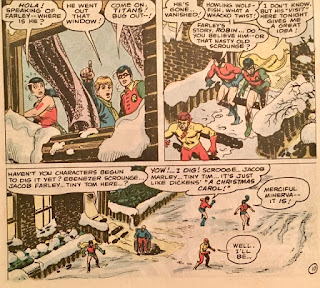Not to be a Grinch about it, but though there's a lot of mythicity in the actual rituals and customs of Christmas, to say nothing of the intersection of pagan myth and Christian worship, not that much mythicity appears in pop-cultural Christmas entertainment. I like sentiment as much as the next fan, but with a few exceptions, like possibly Seuss's original Grinch-fable, holiday cheer doesn't seem to translate into what I've called (in my windy way) "hyperconcrescent symbolic discourse."
Case in point: TEEN TITANS #13, Bob Haney and Nick Cardy's winsomely corny reprise of Dickens' CHRISTMAS CAROL, blended with faux-hip teenaged superheroes. Haney probably guessed that most if not all of his readers had "grooved" on various adaptations of Dickens, and so what better grist for the story-mill than to have the Teen Titans experience almost the same story in "real life," with only minor changes of names and situations:
First the teen heroes sit around reading comic books, while Robin loftily recommends a more portentous author:
And then they start to experience almost the same events of the CAROL.
At no point, surprisingly, do any of the heroes start worrying, a la Will Farrell, that they may be helpless pawns of some capricious author. They just go about solving a crime that involves the skinflint "Mister Scrounge," his employee "Ratchet" and Ratcher's crippled son "Tiny Tom." I'd be lying if I said I hadn't enjoyed the pants off this cornball version of metatextuality back in the day, and that I still enjoyed Cardy's masterful mise-en-scene upon recently rereading same.
However, the closest the comic comes to mythicity is the weird, eye-catching cover:

The idea of having a bunch of good guys pinned to a Christmas tree like living ornaments is by itself nothing special. However, the idea of the faux-tree being made out of a collection of junk is inspired, since Xmas presents usually connote the promise of The New, while Junk connotes the Old and the Unpromising. Further, seeing the heroes are bound by old tires and radiators and bedposts makes it seem as if the junk is alive, preying on the energies of youth. However, even Haney's lunatic imagination couldn't figure out how to justify "junk-that-eats-teens-as-food" (in contradistinction to the more familiar "teens-eat-junk-food"). So in the story proper it's not a tree of junk, just a big conical pile of trash that somehow has the power to magnetically attract the good guys, though not any of the bad guys they're fighting at the time. An added, almost Old-World touch is that the two figures in the foreground-- the "Scrooge" doppelganger and modern-day crook "Mister Big"-- are making deep, flourishing bows to one another as if emulating those turn-of-the-century personifications of politeness, Alphonse and Gaston.






No comments:
Post a Comment